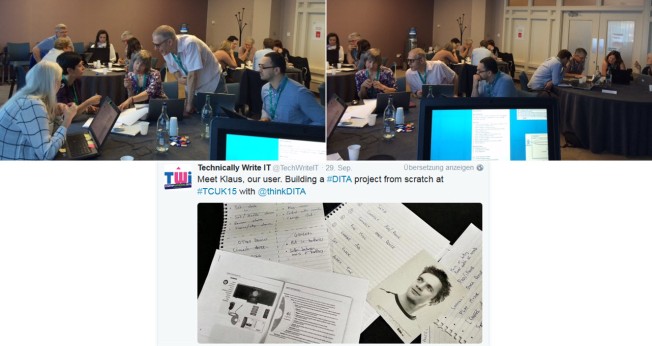Here is my impression of TCUK15, as promised. Enjoy!
Tag Archives: TCUK
Building a DITA pilot project
The DITA pilots were hard at work again at TCUK. We have discussed what changes may come with the DITA implementation, but also what should stay the same… if done properly, namely the research and planing phase of a documentation project. The four working groups designed personas and use cases for a specific product line, then drafted the documentation outline that formed the basis of their DITA project.

You can see the prezi I used for the first part of the workshop here:
Once we had a documentation outline, we started a DITA skeleton project in oXygen XML Editor. It is called a skeleton project, because we started a simple ditamap, just by replicating the outline, without actually creating any topics. We just added symbolic topicref elements and inserted the titles from our outline in navtitle attributes. A skeleton map can even be published for review.
Thus the writers have the entire outline model in the ditamap from the beginning and would be ready to start creating topics and developing the content using the ditamap as guidance, then adding the actual topics to the map in href attributes. This approach can be applied not only to provide orientation while creating new topics and enhancing the model, but also to ensure consistency across documentation sets… at least until fancier project templates are in place.
In case you’d like to try out building a DITA skeleton project, you can download the tutorial as PDF file ![]() .
.
Happy DIT’ing! More entertaining TCUK keepsake from Glasgow coming soon.
Upcoming workshop: Building a DITA pilot project
One more month to go until TCUK 2015 in Glasgow. Have you booked your package yet?
While preparing for the three-hour workshop on Building a DITA pilot project, the sound of bagpipes is bringing Scotland closer, here in Germany. Can’t wait to meet TCUK delegates again and to host another DITA workshop.
You are considering migrating to DITA and would like to see a proof of concept, but don’t know where to start? Bring your laptop to the DITA Pilot workshop and you’ll see how quickly you can get started. We’ll just follow a few steps:
1. Design phase:
– Identify use cases and task analysis
– Outline the information model and its modules
– Set up the project structure2. Production phase:
– Writing the topics and the map
– Publishing PDF and HTML
– ReviewingIt does not take long to be productive in DITA and to prove its value to your team. Take a running project back to the office with you and turn the DITA business case into reality with a demo for your colleagues.
September 29, 2015, 2:00 pm to 5:00 pm
The Beardmore Hotel and Conference Centre, Hall: Clyde
TCUK Website: http://technicalcommunicationuk.com/
DITA Pilots, on your marks…

